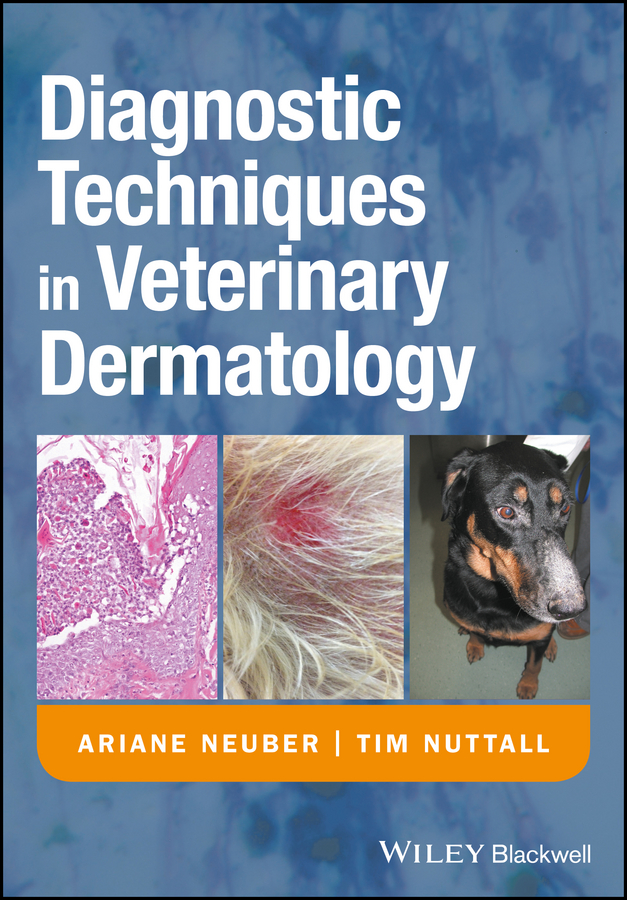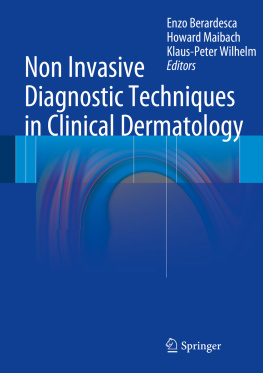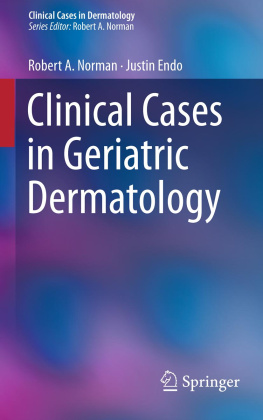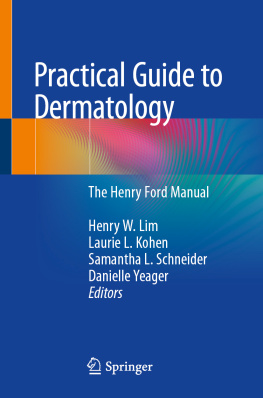Neuber Ariane - Diagnostic Techniques in Veterinary Dermatology
Here you can read online Neuber Ariane - Diagnostic Techniques in Veterinary Dermatology full text of the book (entire story) in english for free. Download pdf and epub, get meaning, cover and reviews about this ebook. year: 2017, genre: Home and family. Description of the work, (preface) as well as reviews are available. Best literature library LitArk.com created for fans of good reading and offers a wide selection of genres:
Romance novel
Science fiction
Adventure
Detective
Science
History
Home and family
Prose
Art
Politics
Computer
Non-fiction
Religion
Business
Children
Humor
Choose a favorite category and find really read worthwhile books. Enjoy immersion in the world of imagination, feel the emotions of the characters or learn something new for yourself, make an fascinating discovery.

- Book:Diagnostic Techniques in Veterinary Dermatology
- Author:
- Genre:
- Year:2017
- Rating:3 / 5
- Favourites:Add to favourites
- Your mark:
- 60
- 1
- 2
- 3
- 4
- 5
Diagnostic Techniques in Veterinary Dermatology: summary, description and annotation
We offer to read an annotation, description, summary or preface (depends on what the author of the book "Diagnostic Techniques in Veterinary Dermatology" wrote himself). If you haven't found the necessary information about the book — write in the comments, we will try to find it.
Diagnostic Techniques in Veterinary Dermatology — read online for free the complete book (whole text) full work
Below is the text of the book, divided by pages. System saving the place of the last page read, allows you to conveniently read the book "Diagnostic Techniques in Veterinary Dermatology" online for free, without having to search again every time where you left off. Put a bookmark, and you can go to the page where you finished reading at any time.
Font size:
Interval:
Bookmark:

This edition first published 2017
2017 Ariane Neuber and Tim Nuttall.
All rights reserved. No part of this publication may be reproduced, stored in a retrieval system, or transmitted, in any form or by any means, electronic, mechanical, photocopying, recording or otherwise, except as permitted by law. Advice on how to obtain permission to reuse material from this title is available at http://www.wiley.com/go/permissions.
The right of Ariane Neuber and Tim Nuttall to be identified as the authors of this work has been asserted in accordance with law.
Registered Office(s)
John Wiley & Sons, Inc., 111 River Street, Hoboken, NJ 07030, USA
John Wiley & Sons Ltd, The Atrium, Southern Gate, Chichester, West Sussex, PO19 8SQ, UK
Editorial Office
9600 Garsington Road, Oxford, OX4 2DQ, UK
For details of our global editorial offices, customer services, and more information about Wiley products visit us at www.wiley.com.
Wiley also publishes its books in a variety of electronic formats and by print-on-demand. Some content that appears in standard print versions of this book may not be available in other formats.
Limit of Liability/Disclaimer of Warranty
The contents of this work are intended to further general scientific research, understanding, and discussion only and are not intended and should not be relied upon as recommending or promoting scientific method, diagnosis, or treatment by physicians for any particular patient. In view of ongoing research, equipment modifications, changes in governmental regulations, and the constant flow of information relating to the use of medicines, equipment, and devices, the reader is urged to review and evaluate the information provided in the package insert or instructions for each medicine, equipment, or device for, among other things, any changes in the instructions or indication of usage and for added warnings and precautions. While the publisher and authors have used their best efforts in preparing this work, they make no representations or warranties with respect to the accuracy or completeness of the contents of this work and specifically disclaim all warranties, including without limitation any implied warranties of merchantability or fitness for a particular purpose. No warranty may be created or extended by sales representatives, written sales materials or promotional statements for this work. The fact that an organization, website, or product is referred to in this work as a citation and/or potential source of further information does not mean that the publisher and authors endorse the information or services the organization, website, or product may provide or recommendations it may make. This work is sold with the understanding that the publisher is not engaged in rendering professional services. The advice and strategies contained herein may not be suitable for your situation. You should consult with a specialist where appropriate. Further, readers should be aware that websites listed in this work may have changed or disappeared between when this work was written and when it is read. Neither the publisher nor authors shall be liable for any loss of profit or any other commercial damages, including but not limited to special, incidental, consequential, or other damages.
Library of Congress Cataloging-in-Publication Data
Names: Neuber, Ariane, 1970- author. | Nuttall, Tim, 1967- author.
Title: Diagnostic techniques in veterinary dermatology : a manual of diagnostic techniques / Ariane Neuber, Tim Nuttall.
Description: Hoboken, NJ, USA : Wiley-Blackwell, 2017. | Includes bibliographical references and index. |
Identifiers: LCCN 2017005977 (print) | LCCN 2017015845 (ebook) | ISBN 9781119233046 (Adobe PDF) | ISBN 9781119233060 (ePub) | ISBN 9781405139489 (paperback)
Subjects: LCSH: Veterinary dermatology. | MESH: Skin Diseasesveterinary | Dog Diseasesdiagnosis | Cat Diseasesdiagnosis
Classification: LCC SF901 (ebook) | LCC SF901 .N48 2017 (print) | NLM SF 992.S55 | DDC 636.089/65dc23
LC record available at https://lccn.loc.gov/2017005977
Cover images: courtesy of the authors
Introduction to Dermatological Tests
Recent studies show that skin and ear diseases comprise 25% of all veterinary consultations. They are often complex and ongoing conditions that are a challenge to manage. Very few can be diagnosed on history and appearance alone. The modern approach to dermatology emphasises using the history and clinical signs to construct a logical differential diagnosis list. The diagnosis is then achieved by utilising appropriate tests to eliminate and/or confirm conditions in the differential diagnosis. On the other hand it is all too easy to become over-reliant on tests; it is most important that the clinical pathology is made to fit the history and clinical signs, not vice versa.
There is a very wide range of tests that can be used to investigate skin problems, but selecting, performing and interpreting the most appropriate tests in each case requires some experience. Many textbooks and journals, however, concentrate on individual skin conditions and assume that the reader is experienced enough to undertake the relevant diagnostic procedures. In practice, some of the most common reasons for poor management of skin conditions involve the inappropriate use of diagnostic tests, suboptimal execution of test procedures, inadequate sample choice and misinterpretation of results. The aim of this book, therefore, is to provide an illustrated, step-by-step guide to help you select, perform and interpret clinical tests and procedures for a range of dermatological presentations.
A wide range of equipment is necessary for thorough examination of the skin, which may seem daunting. The vast majority, however, are inexpensive, non-specialist items that are common to virtually all veterinary practices and do not need special skills to operate. The few items that are expensive and/or need specific training to use are all optional; they are undoubtedly useful, especially to dermatology specialists, but are not necessary to successfully practise veterinary dermatology.
- Good lighting is essential for proper examination of the skin, lesions and collected material. Good fluorescent room lighting is a minimal requirement and a high-intensity spotlight is necessary for any serious examination.
- Flea comb for coat combings ().
- Hand lens or magnifying glass for close examination of the skin, coat and collected material; the large illuminated lenses sold for reading are most useful ().
- A good-quality binocular microscope for examining hair plucks, skin scrapes and cytology ().
- Glass slides for mounting material; frosted slides are easier to label ().
- Cover-slips are essential for any microscopic examination ().
- Immersion oil for using the 100 oil immersion microscope lens; different types of oil with different viscosities are available. Type A is the least viscous and is often preferred as it is the least messy and the cheapest. Type NVH is the most viscous. For in-house use, type B would also be suitable also but it is messier than type A ().
- Lens tissue or cloth and cleaning fluid or alcohol for cleaning microscope lenses without damage.
- Otoscope for examining the ears ().
- Wood's lamp for screening for fluorescent dermatophytes ().
- Electric clippers for removing hair, allowing access to the skin.
- Curved scissors for more precise and less traumatic hair removal.
- Fine-tipped curved artery (mosquito) forceps for hair plucks ().
Font size:
Interval:
Bookmark:
Similar books «Diagnostic Techniques in Veterinary Dermatology»
Look at similar books to Diagnostic Techniques in Veterinary Dermatology. We have selected literature similar in name and meaning in the hope of providing readers with more options to find new, interesting, not yet read works.
Discussion, reviews of the book Diagnostic Techniques in Veterinary Dermatology and just readers' own opinions. Leave your comments, write what you think about the work, its meaning or the main characters. Specify what exactly you liked and what you didn't like, and why you think so.











